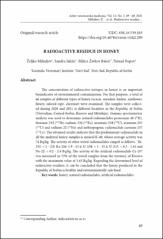Radioactive residue in honey

View/
Date
2021Author
Mihaljev, Željko
Jakšić, Sandra
Živkov-Baloš, Milica
Popov, Nenad
Metadata
Show full item recordAbstract
Th e concentration of radioactive isotopes in honey is an important
bioindicator of environmental contamination. For that purpose, a total of
66 samples of diff erent types of honey (acacia, meadow, linden, sunfl ower,
fl ower, oilseed rape, chestnut) were examined. Th e samples were collected during 2020 and 2021 at diff erent localities in the Republic of Serbia
(Vojvodina, Central Serbia, Kosovo and Metohija). Gamma spectrometric
analysis was used to determine natural radionuclides potassium-40 (40K),
thorium-232 (232Th ), radium-226 (226Ra), uranium-238 (238U), uranium-235
(235U) and sodium-22 (22Na) and anthropogenic radionuclide caesium-137
(137Cs). Th e obtained results indicate that the predominant radionuclide in
all the analyzed honey samples is natural K-40, whose average activity was
74 Bq/kg. Th e activity of other tested radionuclides ranged as follows: Th -
232: < 1 - 2.0; Ra-226: 1.9 - 15.6; U-238: < 1 - 31.4; U-235: < 0.2 - 1.61 and
Na-22: < 0.2 - 2.4 Bq/kg. Th e activity of the artifi cial radionuclide Cs-137
was measured in 53% of the tested samples from the territory of Kosovo
with the maximum value of 3.63 Bq/kg. Regarding the determined level of
radioactive residues, it can be concluded that the honey produced in the
Republic of Serbia is healthy and environmentally safe food.
